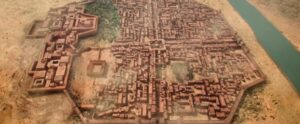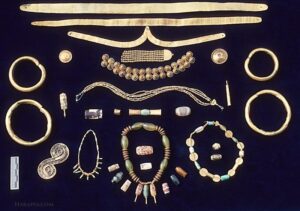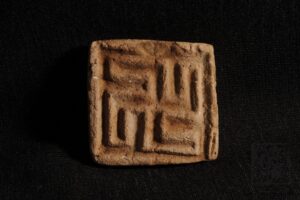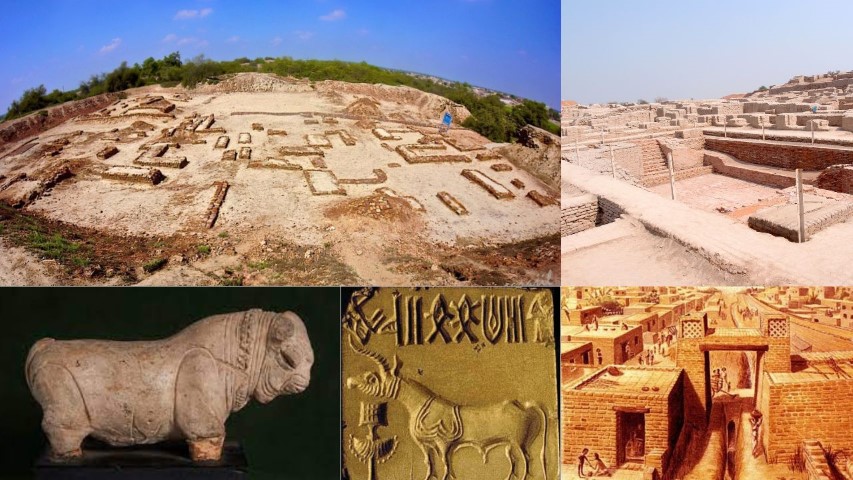25. What is the Indus Valley civilization known for?
Ans: The Indus Valley Civilization is known as the first urbanization in India.
26. What were the metals that the people of the Indus Valley Civilization were familiar with?
Ans: The people of the Indus Valley Civilization were familiar with copper, silver, gold, and bronze (occasionally mixed arsenic with copper instead of tin).
27. Was iron known to the people of the Indus Valley Civilization?
Ans: The people of the Indus Valley Civilization did not know about iron.
28. Did the people of the Indus Valley Civilization use the wheel?
Ans: Yes, the people of the Indus Valley Civilization were aware of the use of the wheel.

29. What were some of the important crafts practiced by the people of the Indus Valley Civilization?
Ans: Some of the important crafts practiced by the people of the Indus Valley Civilization were spinning, bricklaying, boat-making, seal-making, terracotta manufacturing (using the potter’s wheel), goldsmiths, and bead-making.
30. How were the towns in the Indus Valley Civilization laid out?
Ans: The towns in the Indus Valley Civilization were laid out in a rectangular grid pattern
with roads at right angles.

31. What were the building materials used in the Indus Valley Civilization?
Ans: The people of the Indus Valley Civilization used burnt mud bricks joined with gypsum mortar as building materials.
32. Did most buildings in the Indus Valley Civilization have private wells and properly ventilated bathrooms?
Ans: Yes, most buildings in the Indus Valley Civilization had private wells and properly ventilated bathrooms.
33. How was the city in the Indus Valley Civilization divided?
Ans: In the Indus Valley Civilization, the city was divided into two parts: the Upper Citadel and the Lower Town.
34. What were the main crops cultivated by the Indus Valley Civilization?
Ans: The main crops cultivated by the Indus Valley Civilization were wheat and barley.
35. Apart from wheat and barley, what other crops were cultivated by the people of the Indus Valley Civilization?
Ans: The people of the Indus Valley Civilization also cultivated rice (in Lothal and Rangpur), dates, mustard, sesamum, cotton, rai, and peas.
36. What were some of the goods that the Indus Valley Civilization imported and exported through trade?
Ans: The Indus Valley Civilization imported goods such as gold, silver, copper, tin, jade, steatite, and bitumen from places like Afghanistan, Iran, and Mesopotamia. They exported agricultural products, cotton goods, terracotta figurines, beads, conch-shell, ivory products, and copper.
37. How did the Indus Valley Civilization conduct their trade without metallic money?
Ans: The Indus Valley Civilization conducted their trade through bartering goods and services, as they did not have metallic money in circulation.
38. Who were some of the important classes in the social organization of the Indus Valley Civilization?
Ans: Merchants and priests were important classes in the social organization of the Indus Valley Civilization.
39. What were some of the cosmetic products used by the Indus Valley Civilization?
Ans: The Indus Valley Civilization commonly used cosmetics such as cinnabar, lipstick, and collyrium.
40. What were some of the jewelry and ornamentation were worn by men and women in the Indus Valley Civilization?
Ans: Both men and women wore necklaces, filets, armlets, and finger rings. Women also wore bangles, girdles, anklets, and earrings. People made beads from various materials, including gold, copper, bronze, cornelian, quartz, steatite, and lapis lazuli. They also used naturalistic animal models such as pinheads and beads.

41. What were the recurring themes of the paintings on the Harappan pottery?
Ans: Trees, birds, animal figures, and geometrical patterns were the recurring themes of the paintings.
42. What was the purpose of Harappan seals?
Ans: Harappan seals were primarily used for commercial purposes, as an amulet, as a form of identification, for educational purposes as well.
43. What was the standard of weights used by the Harappans?
Ans: The local Dilmun weights followed the Harappan standard.
44. What was the primary material used to make Harappan seals?
Ans: Harappan seals were primarily made from Steatite.
45. What was the purpose of Harappan seals?
Ans: Harappan seals were used for commercial purposes, as an amulet, as a form of identification, and for educational purposes as well.
46. What kind of figures or inscriptions were commonly found on Harappan seals?
Ans: Harappan seals had an animal (except cow and horse) or human figure on one side and an inscription on the opposite side or inscriptions on both sides.
47. Were there any particular symbols that were commonly found on Harappan seals?
Ans: Archaeologists have found Harappan seals with symbols similar to the Swastika design.

48. When did the Indus Valley Civilization decline?
Ans: The Indus Valley Civilization declined after 2000 BC and gradually faded away.
49. What are the possible reasons for the decline of the Indus Valley Civilization?
Ans: The possible reasons for the decline of the Indus Valley Civilization include declined soil fertility, depression in the land, Aryan invasion, decline of trade, floods, and earthquakes.
50. During the archaeological excavation of the Harappa Civilisation, what types of civic planning representation were seen?
Ans: Houses, markets, storage facilities, offices, and almost every basic thing are organized in a grid-like pattern and roads were cut crossways each other’s at 90-degree, and the city was organized into blocks design.

